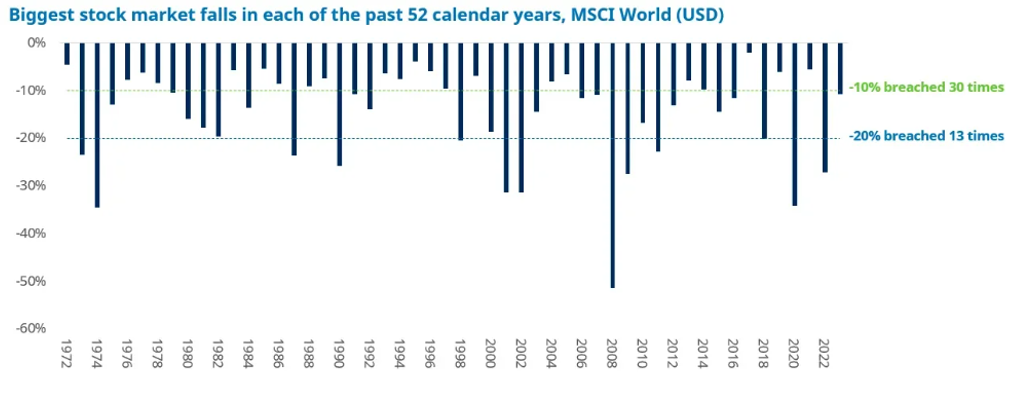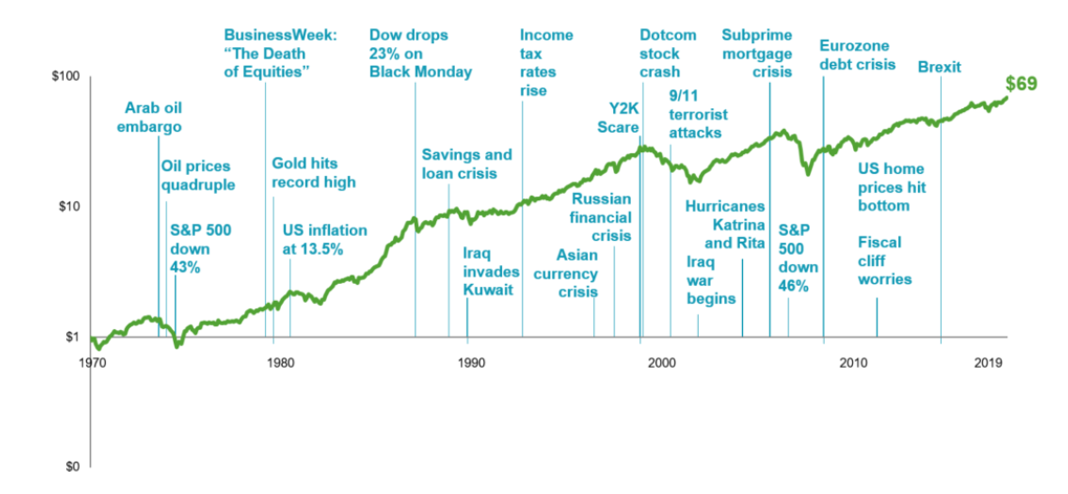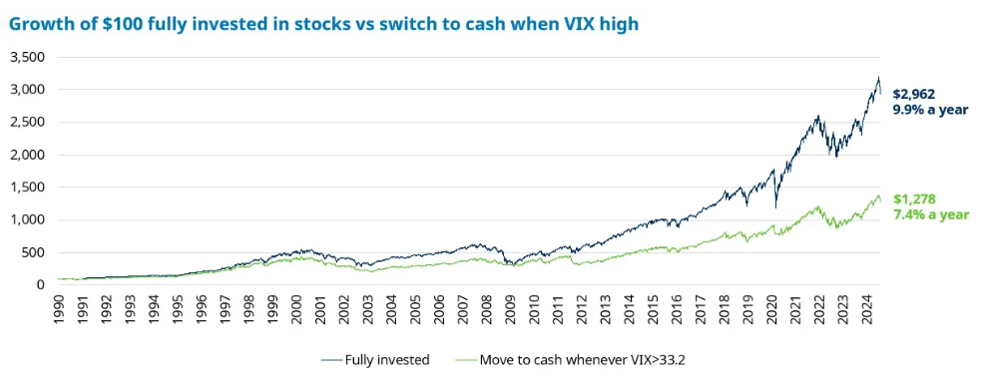With ongoing conflicts, rising geopolitical tensions, and instability surrounding US trade relations, recent news may have left you feeling nervous, not just about global events, but also about your investments.
During times of uncertainty, it’s not uncommon for markets to be volatile, as investor sentiment wavers. However, despite periods of volatility, markets have repeatedly shown resilience and a long-term upward trajectory – even in the face of major global events.
History shows that the most effective way to grow wealth and recover from setbacks is to tune out short-term “noise” and stay focused on your long-term goals.
Read on to learn more about how to remain disciplined amid market volatility and wider uncertainty.
Market drops are a common occurrence
A key part of tuning out the noise and ignoring short-term trends that can lead to knee-jerk reactions is to understand how frequent significant market declines actually are. And that, despite the regularity of such volatility, markets have consistently delivered strong long-term returns.
Indeed, research into the performance of the MSCI World Index over a 52-year period shows that double-digit declines in global stock markets occur more often than not in any given year – as you can see in the graph below.

Source: Schroders
Over the 52 years studied, the index experienced 10% declines on 30 occasions, and more severe drops of 20% or more occurred 13 times.
To put that in context, after Donald Trump announced US trade tariffs on 2 April, data from the London Stock Exchange shows the FTSE All-Share fell by over 10%, yet it rebounded and reached a new all-time high just two months later.
Similarly, despite the frequency and scale of downturns, the MSCI World Index has shown continuous long-term growth.
The chart below illustrates how $1 invested in the MSCI World Index in 1970 grew through to 2019, even amid major global events that triggered sharp market declines.

Source: Harvest
Individual companies can also experience severe declines followed by strong recoveries. For example, after the launch of DeepSeek, Nvidia saw its market value drop by $600 billion in a single day in January, marking the largest one-day loss in history. Yet the company quickly rebounded and recently became the world’s first to reach a $4 trillion market cap.
So, it’s important to recognise that market drops are a normal part of the investment journey and it’s typically best to remain disciplined and resilient during such periods.
If you exit the market during a downturn, you may miss the opportunity to recover
When markets fall sharply, you may feel inclined to want to sell in order to limit further losses. But unless you actually sell, a drop in value is only a paper loss. By remaining invested, you give your portfolio the opportunity to recover, which is something markets have consistently done over time.
For instance, research by Schroders found that an investor who moved to cash after a 25% drop in 1929 wouldn’t have broken even until 1963. However, had they stayed invested, they would have recovered by 1945.
A similar pattern played out in 2008. Investors who switched to cash after the first 25% decline would still be recouping losses today, while those who stayed the course saw their portfolios recover by 2013.
In fact, selling during volatile periods can be just as risky as selling after a major crash.
The VIX – often referred to as the stock market’s “fear gauge” – measures expected volatility in the S&P 500 over the next 30 days. When Trump announced trade tariffs, the VIX spiked to its highest level since the start of the pandemic in 2020.
Schroders’ analysis suggests that selling during these periods of high volatility could have significantly hurt your long-term returns.
Their research tested a strategy where investors exited the market whenever the VIX rose above 33.2, and then only re-entered once it fell below that level. The performance of $100 under this approach is shown in the graph below.

Source: Schroders
As you can see, a strategy of selling when the VIX was elevated would have delivered annual returns of just 7.4%. In contrast, staying fully invested in the stock market would have returned 9.9%.
In other words, moving to cash during times of volatility may feel like a safe short-term decision, but it can undermine your portfolio’s long-term growth and delay your recovery. Staying invested through such periods has historically led to better outcomes.
A financial planner can help you tune out the noise and build a well-diversified portfolio designed to stay resilient through volatility
During times of uncertainty and amid volatile markets, it be hard to stay focused on your long-term goals, but that’s where a financial planner can help.
They can work with you to build a plan tailored to your goals and risk tolerance, helping you stay disciplined through short-term noise and market dips. By focusing on the bigger picture and recognising that fluctuations are a normal part of the journey, you can stay on track during periods of volatility.
A financial planner can also help you diversify your portfolio, ensuring your wealth is spread across a range of asset classes, regions, and markets. This approach means that losses in one area can be offset by gains in another, allowing for a steadier path to growth.
Our team of independent financial advisers in Lewes is here to support you in maintaining discipline and focus during difficult times.
To find out more, please get in touch by emailing us at financial@barwells-wealth.co.uk or by phone on 01273 086 311.
Please note
This article is for general information only and does not constitute advice. The information is aimed at retail clients only.
All information is correct at the time of writing and is subject to change in the future.
The value of your investments (and any income from them) can go down as well as up and you may not get back the full amount you invested. Past performance is not a reliable indicator of future performance.







 Production
Production